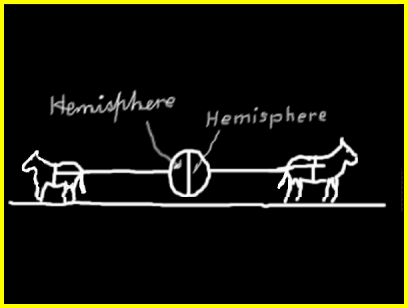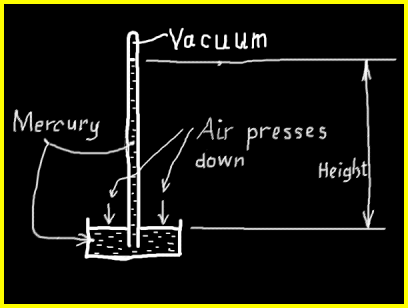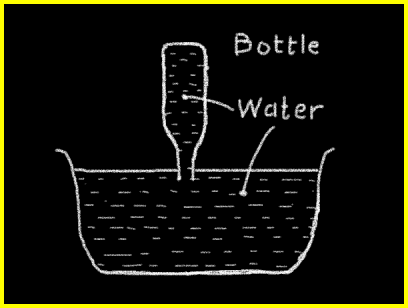3
Torricelli’s Jelly Belly
A long time ago inventors and
people like that had great fun with horses and
hemispheres and making new discoveries. Miss Tumble
said they were just ordinary people, like the
children and herself, who thought about the world
around them. It’s a pity that Freddie and Eve
didn’t have horses and hemispheres in their
classroom. Steam and electric kettles were all very
well, but horses and hemispheres would have been
mega fun!
Miss Tumble drew a large
circle in the middle of the blackboard and divided
it in two with a vertical line. She said the
diagram represented a sphere divided into two
hemispheres. “Who could write hemisphere on
the blackboard?” she asked. Coleman and Eve
were the first two to put up their hands. Miss
Tumble gave each of them a piece of chalk and asked
them to write hemisphere on opposite sides of the
diagram representing the sphere. Eve had hemisphere
written first. Coleman needed a little reminder
from Miss Tumble that there was an ‘e’
at the end. Miss Tumble gave them each a prize of a
lollipop, which was in the shape of a sphere.
Freddie thought this was most unfair, as hemisphere
had only ten letters in it. He said
“that’s not fair” to Coleman when
Coleman returned to his seat. Coleman didn’t
mind. He was perfectly happy with his spherical
lollipop. He knew it would last a long time if he
sucked it slowly. Eve was delighted with her prize
too, even though she didn’t care much for
lollipops.
Long ago there was a man who
lived in Magdeburg who had horses, ropes and plenty
of helpers. He also happened to have a
 sphere made up of two
hemispheres that fitted together. The hemispheres
came apart very easily. The man's name was Otto von
Guericke. He invented a pump that was able to pump
the air out of the sphere when the two hemispheres
had been placed together. The seal between the
hemispheres was good enough to prevent any air from
leaking back in from the surroundings. Otto von
Guericke was able to show that when the air was
removed from within the sphere the hemispheres
remained tightly pressed together. He attached a
strong rope to each hemisphere and arranged for
horses to pull the ropes in an attempt to separate
the hemispheres. All the people who came to
watch were very impressed when the horses were
unable to pull the hemispheres apart. As soon as
von Guericke allowed air into the sphere again, the
hemispheres separated. The audience thought von
Guericke was wonderful. News of the experiment
spread and it gave many people an appreciation of
the great force with which the air of the atmosphere pressed on things.
sphere made up of two
hemispheres that fitted together. The hemispheres
came apart very easily. The man's name was Otto von
Guericke. He invented a pump that was able to pump
the air out of the sphere when the two hemispheres
had been placed together. The seal between the
hemispheres was good enough to prevent any air from
leaking back in from the surroundings. Otto von
Guericke was able to show that when the air was
removed from within the sphere the hemispheres
remained tightly pressed together. He attached a
strong rope to each hemisphere and arranged for
horses to pull the ropes in an attempt to separate
the hemispheres. All the people who came to
watch were very impressed when the horses were
unable to pull the hemispheres apart. As soon as
von Guericke allowed air into the sphere again, the
hemispheres separated. The audience thought von
Guericke was wonderful. News of the experiment
spread and it gave many people an appreciation of
the great force with which the air of the atmosphere pressed on things.

Magdeburg hemispheres
The
hemispheres were known as Magdeburg hemispheres,
after the town that von Guericke came from.
Miss Tumble explained that
when the air had been pumped out of the sphere
there was no longer anything pushing the
hemispheres apart from the inside, yet on the
outside the air of the atmosphere was still pushing
the hemispheres together, so they stayed together.
It would have taken more horses to separate them by
pulling. However, once there was air pushing
equally from inside and from outside, the
hemispheres separated easily.
Some of the children did not
understand what
pressure was. Miss Tumble said that pressure
was the effect of a gas (such as air or steam) or a
liquid (such as water or mercury) pressing on
something. A solid like rubber could also exert
pressure, as when the sole of someone’s shoe
pressed on the ground.
It wasn’t always
necessary to have equipment in order to carry out
an experiment. Miss Tumble asked all the children
to keep their mouths closed and blow into their
cheeks. They all laughed when she showed them how
because it made her face look very fat and rounded.
The children all enjoyed puffing out their cheeks.
Miss Tumble said their cheeks moved out because the
pressure of the air inside their mouths was greater
than the pressure of the air outside. The air
inside was pressing harder than the air outside.
Next Miss Tumble asked the
children to keep their mouths
closed, allow their chins to move downwards a
little and then suck in their cheeks. They all did this after Miss
Tumble had shown them how. In this case the pressure of the air inside
their mouths was lower than the pressure of the air outside, so their
cheeks moved inwards.
Miss Tumble asked the children if they knew what a
vacuum was. They
all knew what a vacuum cleaner was: a machine for cleaning the house by
sucking up dirt. Miss Tumble said that a vacuum cleaner worked by
creating a partial vacuum. A powerful pump inside it pumped air away
very fast. The pressure inside the vacuum cleaner was then lower than
the pressure of the surrounding air. Because of this the atmosphere
pushed air into the suction tube of the vacuum cleaner. This air
rushing into the tube was like a strong wind that carried any loose
dust or dirt into the vacuum cleaner.
Freddie asked why the vacuum cleaner only created
a partial vacuum. Miss Tumble said that in a perfect vacuum there would
be no gas whatsoever present within a given space. If there was no gas
at all present there would be no pressure, but if there was some gas
present then it would be able to exert some pressure. The pump of a
vacuum cleaner was not able to remove all the air from within it.
Therefore, the space where the pressure had been reduced was said to be
under a partial vacuum. When Otto von Guericke carried out his famous
Magdeburg hemispheres experiment there would have been a
partial vacuum inside the
sphere, rather than a
perfect vacuum.
Miss Tumble said the pressure
of the atmosphere was due to the weight of all the
air above us. As another story, Miss Tumble told
the class that a man called Torricelli had invented
a device called a
barometer
that could measure how hard the air of
the atmosphere pressed on things. In the barometer
the weight of some liquid in a tube was
 balanced against the weight of
the air in the atmosphere. The pressure of the
atmosphere was enough to support a height of 10
metres of water – the height of a two-storey
house. Miss Tumble said that Torricelli could have
used water in his barometer, but that it would then
have been too tall to be practical. Mercury was a
very heavy liquid metal and the pressure of the
atmosphere was only able to support mercury in a
tube to a height of about 760 millimetres. It was a
very clever idea of Torricelli’s to use
mercury in his barometer, because it made the
barometer small enough for practical use.
balanced against the weight of
the air in the atmosphere. The pressure of the
atmosphere was enough to support a height of 10
metres of water – the height of a two-storey
house. Miss Tumble said that Torricelli could have
used water in his barometer, but that it would then
have been too tall to be practical. Mercury was a
very heavy liquid metal and the pressure of the
atmosphere was only able to support mercury in a
tube to a height of about 760 millimetres. It was a
very clever idea of Torricelli’s to use
mercury in his barometer, because it made the
barometer small enough for practical use.

Torricelli's mercury barometer
It had taken a lot of
concentration on the part of the children to try to
understand Torricelli’s barometer and it was
still not easy for them to see how the pressure of
the atmosphere could
support the liquid mercury in the tube of the
barometer. They were very pleased when
 Miss Tumble said they could all do an experiment
that would help them to understand this. She had a large basin of water
and a lemonade bottle on her table. Each child had a chance to submerge
the bottle in the water and allow all the air to escape from it. They
then turned the bottle so that it was upside-down with the neck opening
still below the water surface. They found that as long as the opening
of the bottle was under the water, no air could enter it and it
remained full.
Miss Tumble said they could all do an experiment
that would help them to understand this. She had a large basin of water
and a lemonade bottle on her table. Each child had a chance to submerge
the bottle in the water and allow all the air to escape from it. They
then turned the bottle so that it was upside-down with the neck opening
still below the water surface. They found that as long as the opening
of the bottle was under the water, no air could enter it and it
remained full.

Bottle and basin experiment
Miss Tumble explained that the pressure of the
atmosphere was supporting the weight of the water inside the bottle.
She told the children that if they had a bottle that was more than ten
metres tall a vacuum would be created above the water in the bottle, as
the pressure of the atmosphere was only sufficient to support about 10
metres of water. The children were fascinated at the thought of a
lemonade bottle more than ten metres tall. They wished they had one to
check out what Miss Tumble had said. Except for Jennifer: she just
wished she had one full of lemonade – she was very fond of
lemonade.
Damien whispered to Janice
that a Magdeburg hemisphere was like a fat belly.
Janice said it was like Torricelli’s jelly
belly, but she was laughing so much that she forgot
to whisper very softly. Miss Tumble heard what
Janice said, but didn’t really get the joke.
She had to get quite cross before everyone would
stop laughing. She put Damien and Janice standing
on opposite sides of the classroom for ten minutes.
Miss Tumble must have forgotten about that when she
promised the class that they would be going on an
outing to the Steam Museum at Straffan.
